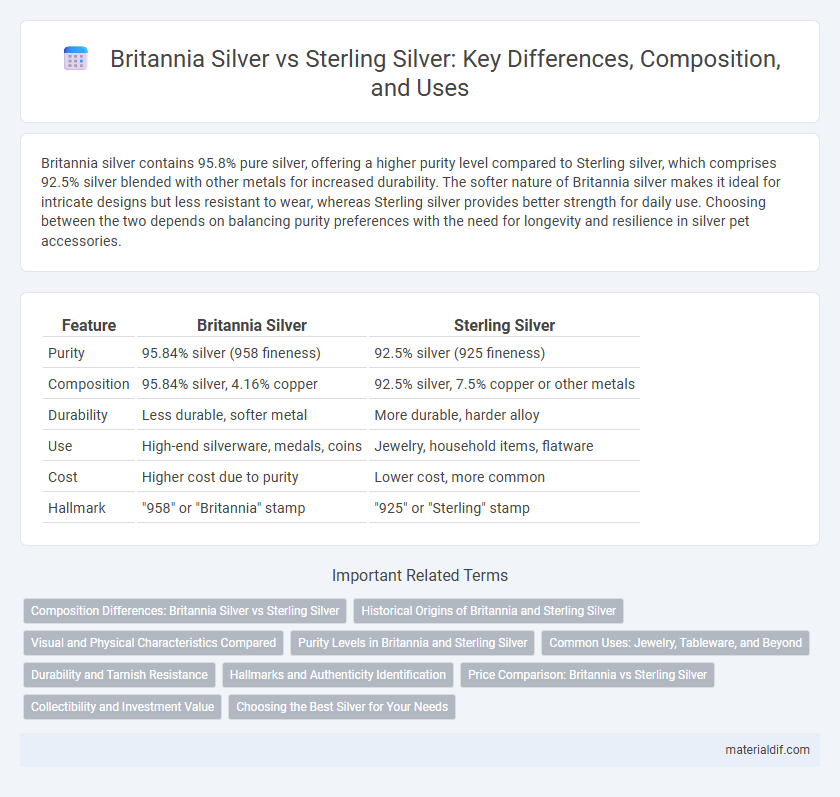Britannia silver contains 95.8% pure silver, offering a higher purity level compared to Sterling silver, which comprises 92.5% silver blended with other metals for increased durability. The softer nature of Britannia silver makes it ideal for intricate designs but less resistant to wear, whereas Sterling silver provides better strength for daily use. Choosing between the two depends on balancing purity preferences with the need for longevity and resilience in silver pet accessories.
Table of Comparison
| Feature | Britannia Silver | Sterling Silver |
|---|---|---|
| Purity | 95.84% silver (958 fineness) | 92.5% silver (925 fineness) |
| Composition | 95.84% silver, 4.16% copper | 92.5% silver, 7.5% copper or other metals |
| Durability | Less durable, softer metal | More durable, harder alloy |
| Use | High-end silverware, medals, coins | Jewelry, household items, flatware |
| Cost | Higher cost due to purity | Lower cost, more common |
| Hallmark | "958" or "Britannia" stamp | "925" or "Sterling" stamp |
Composition Differences: Britannia Silver vs Sterling Silver
Britannia silver contains 95.83% pure silver, marked as .958, offering higher purity than sterling silver's 92.5% purity, denoted as .925. The increased silver content in Britannia silver results in a softer alloy, while sterling silver's copper composition provides greater durability and strength. These composition differences influence Britannia silver's suitability for fine, decorative items and sterling silver's preference for functional, everyday jewelry and tableware.
Historical Origins of Britannia and Sterling Silver
Britannia silver originated in England in 1697 as a higher purity standard set at 95.84% silver to prevent coin melting during a silver shortage, while Sterling silver, established in the 12th century, has a consistent purity of 92.5% silver. Britannia silver was introduced by the English government to promote a more refined silver alloy for official use, contrasting Sterling's long-established tradition for durability and practical applications. The hallmarking of both standards reflects their distinct historical origins and usage in British silver craftsmanship.
Visual and Physical Characteristics Compared
Britannia silver, composed of 95.8% silver, presents a brighter, whiter appearance with a softer and more malleable texture compared to Sterling silver, which contains 92.5% silver and is harder due to its copper alloy. The higher purity of Britannia silver results in a smoother, less tarnish-prone surface, while Sterling silver's durability makes it more resistant to scratches and dents. Visually, Britannia silver has a finer grain structure, giving it a more lustrous finish, whereas Sterling silver often displays a warmer, slightly darker tone due to its alloy content.
Purity Levels in Britannia and Sterling Silver
Britannia silver is composed of 95.8% pure silver, making it purer than sterling silver, which contains 92.5% pure silver. The higher purity in Britannia silver results in a softer metal that is often preferred for intricate designs and high-quality silverware. Sterling silver's slightly lower purity level provides enhanced durability, making it ideal for jewelry and everyday items.
Common Uses: Jewelry, Tableware, and Beyond
Britannia silver, composed of 95.8% pure silver, is favored for decorative tableware and high-quality jewelry due to its bright luster and resistance to tarnish, making it ideal for heirloom pieces and fine cutlery. Sterling silver, containing 92.5% silver and 7.5% other metals like copper, offers greater durability and strength, which suits everyday jewelry, flatware, and household items subject to frequent use. Both types serve distinct purposes in jewelry and tableware, with Britannia silver emphasizing elegance and Sterling silver prioritizing practicality and versatility.
Durability and Tarnish Resistance
Britannia silver, composed of 95.8% pure silver, offers superior tarnish resistance compared to Sterling silver, which contains 92.5% silver mixed with stronger copper alloys. Sterling silver's higher copper content increases its durability and strength, making it more suitable for everyday wear and intricate designs. However, Britannia silver's purity ensures better resistance to corrosion and tarnishing, making it ideal for items prioritizing longevity and aesthetic preservation.
Hallmarks and Authenticity Identification
Britannia silver, alloyed with 95.8% silver, is marked with the Britannia hallmark featuring a seated figure of Britannia, ensuring its authenticity and purity distinct from Sterling silver's 92.5% silver content marked by the lion passant hallmark. The clear visual difference in hallmarks allows collectors and jewelers to verify the silver quality and origin confidently, as Britannia silver was introduced in 1697 to enhance silvery purity standards. Authenticity identification relies heavily on these standardized marks, making hallmark inspection crucial for distinguishing genuine Britannia silver from Sterling silver.
Price Comparison: Britannia vs Sterling Silver
Britannia silver, with a purity of 95.8% compared to Sterling silver's 92.5%, generally commands a higher price due to its higher silver content and rarity in the market. The increased fineness of Britannia silver results in a softer metal, making it less common for everyday items and more desirable for specialized collections, influencing its premium pricing. Sterling silver's balance of durability and silver content makes it more affordable and widely used, reinforcing its position as a cost-effective choice for jewelry and cutlery.
Collectibility and Investment Value
Britannia silver, composed of 95.8% pure silver, is prized for its high purity, making it highly collectible among enthusiasts who seek rarity and historical significance, especially in limited edition coins and antique pieces. Sterling silver, with 92.5% purity, maintains strong investment value due to widespread use in jewelry and tableware, offering greater liquidity and market demand. Collectibility of Britannia silver often commands premium pricing in auction markets, while Sterling silver benefits from consistent resale potential and broader market appeal.
Choosing the Best Silver for Your Needs
Britannia silver, composed of 95.8% pure silver, offers superior purity and a brighter finish, making it ideal for high-quality jewelry and decorative items. Sterling silver contains 92.5% silver and 7.5% other metals, providing greater durability and resistance to wear, suitable for everyday silverware and items requiring strength. Choosing between Britannia and Sterling silver depends on prioritizing purity and appearance versus hardness and longevity for your specific needs.
Britannia silver vs Sterling silver Infographic

 materialdif.com
materialdif.com